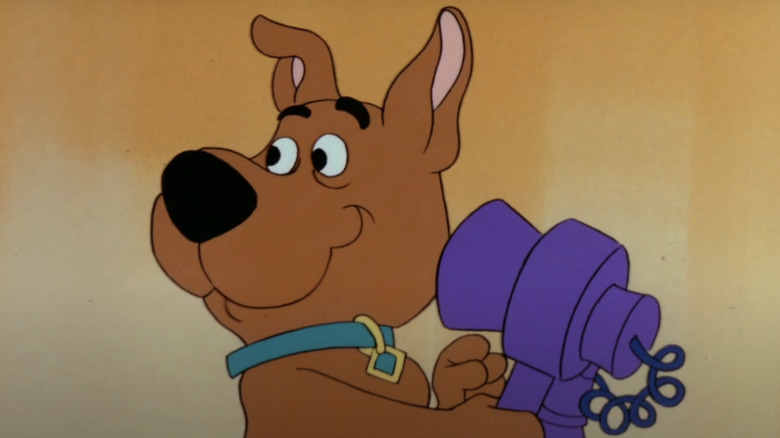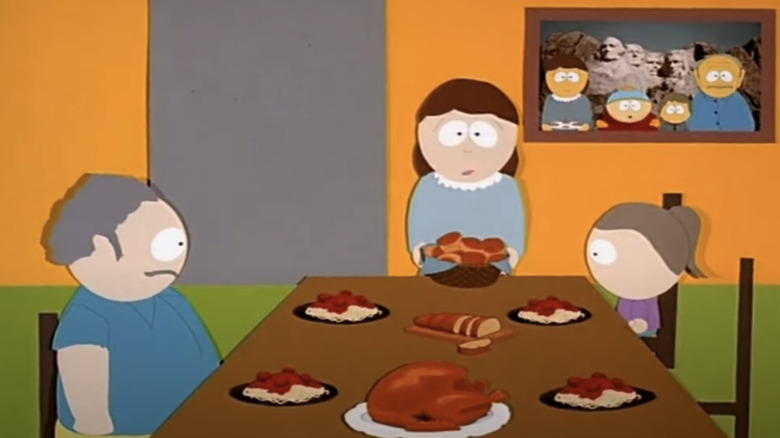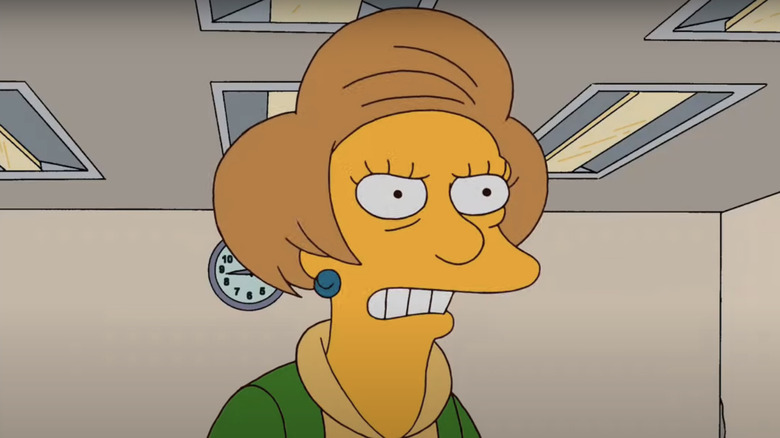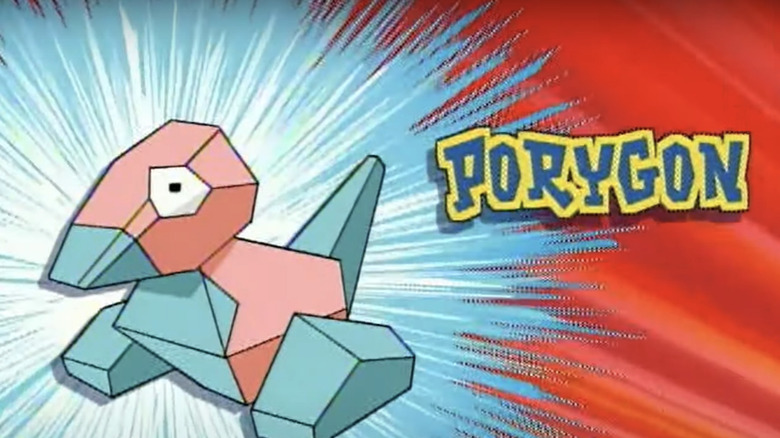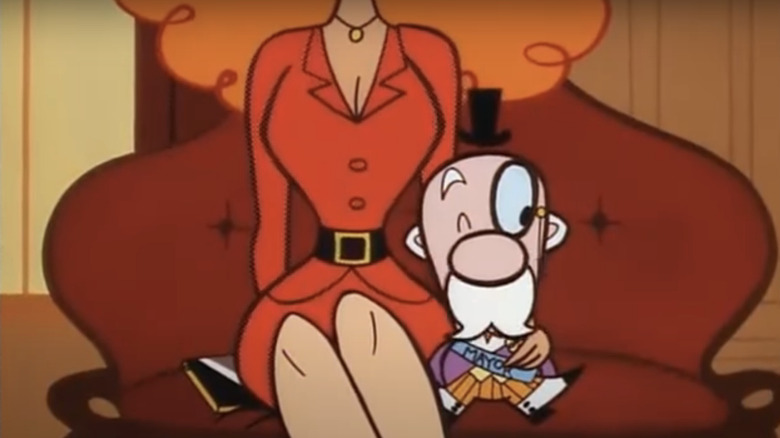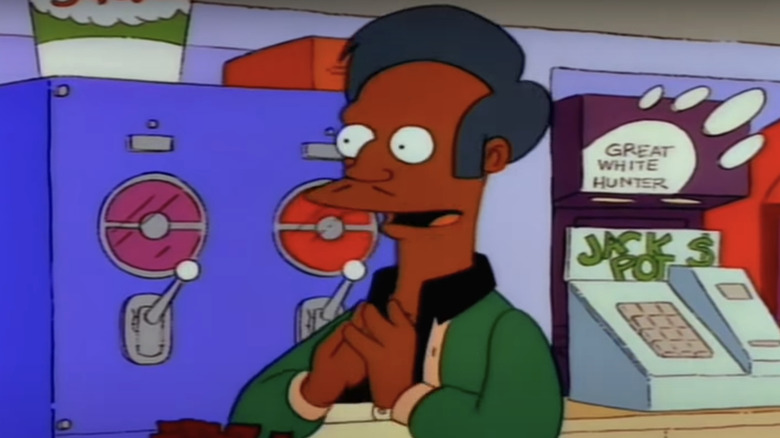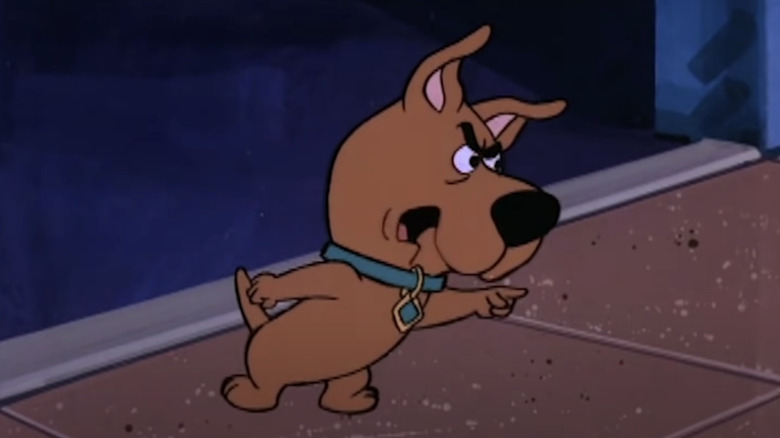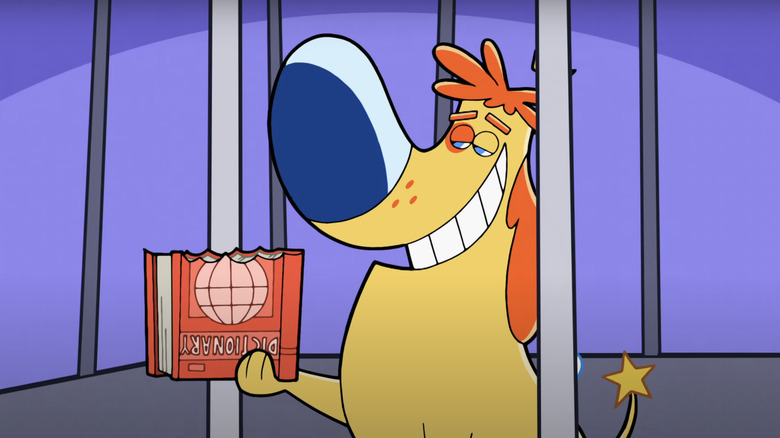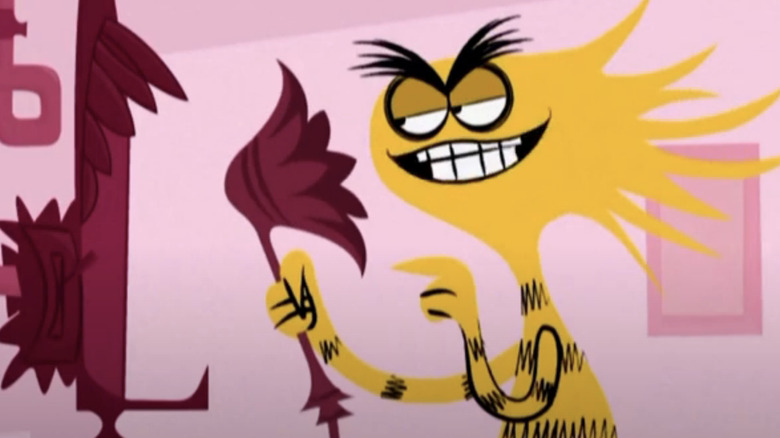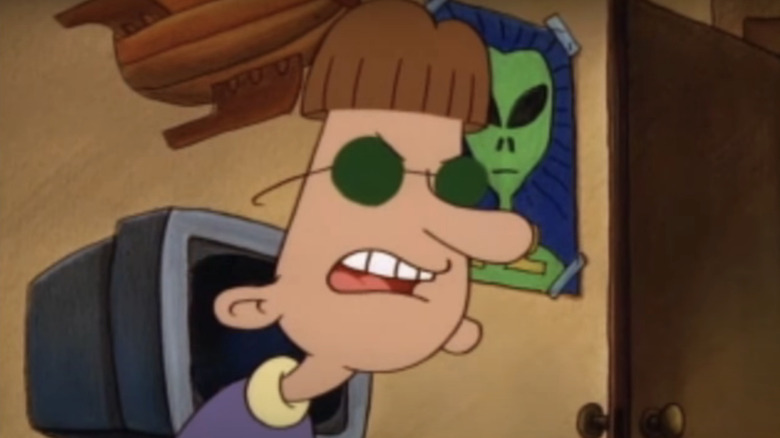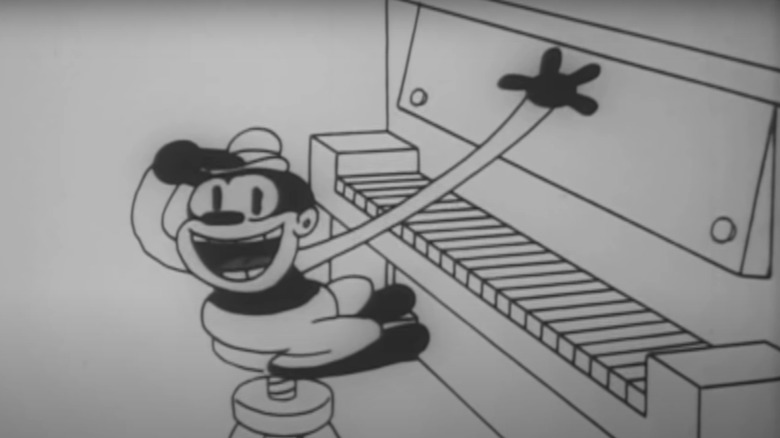The Real Reason These Cartoon Characters Were Cut From The Show
We may receive a commission on purchases made from links.
Animation has many iconic characters, some born from the genesis of the medium's Golden Age: Mickey Mouse, Tom and Jerry, Bugs Bunny, and Daffy Duck, to name a few. In the decades since, countless new animated beings have arrived on the scene — from "PAW Patrol" to "Shirt Tales," "Ninja Turtles" to "Hong Kong Phooey," "Shrek" to "Bigmouth" — some orbiting these classic characters, others newbies trying to launch their own phenomenon. It can be a real a hit-and-miss affair.
While few become the best cartoon characters of all time, and the majority fade into obscurity, there are others whose ultimate fate is a bit more mysterious. Whether due to controversy, lack of popularity, or just plain inability to make a mark, their creators (or networks) felt it best to wipe them away from their drawing boards for good. As a result, they disappeared at some point in their shows; after all, since cartoons often don't need to adhere to the same continuity requirements as a live-action series, it's much easier to pull a Chuck Cunningham.
Below, cartoon characters who were erased as quickly as they were drawn up, and the reasons why they went away.
Eric Cartman's father and sister (South Park)
In "South Park," the identity of Eric Cartman's father was for many years a coy, playful mystery between Trey Parker/Matt Stone and the audience. The absence of a father figure in Eric's upbringing generated many fan theories and attempts at cracking their identity; much like the state that Springfield is in on "The Simpsons," every time the cartoon seemed to commit itself, a humorous detail would follow up that would renew the mystery. Much of the humorous mystery surrounding Cartman's parentage was predicated by the notion that his mother Liane was quite promiscuous.
The de facto explanation given to audiences (and Eric) through many seasons was that Liane was a hermaphrodite and had fathered Eric herself. This turned out to be a lie, as Eric's father was revealed in the show's fourteenth season to be Jack Tenorman, someone Eric had killed nearly nine seasons prior.
But the decision to give Eric an absent father wasn't the original intention of the creators; it was born out of necessity. Eric's then-unnamed father and sister were initially glimpsed in a shot from the original, unaired version of the pilot episode "Cartman Gets an Anal Probe," when the entire family is seated at the dinner table. Creators Matt Stone and Trey Parker revealed through the show's Season 1 commentary that network Comedy Central could only air 22 minutes of the 28-minute-long pilot, so Stone and Parker had to cut several scenes and subplots — including Eric's non-speaking father and sister.
Edna Krabappel (The Simpsons)
On the surface level, it seems as though the mischievous Bart Simpson would have a contentious relationship with his elementary school teacher, Edna Krabappel (named in quasi-tribute to Miss Crabtree, teacher of "The Little Rascals"). After all, it's Edna who punished Bart by having him write on the chalkboard, as seen time and again in the show's intro. Although this was often the case, there were also several heartfelt moments on the series; ultimately, Edna proved to be a supportive teacher to Bart, a sentiment reciprocated when Bart nominated Edna for the "Teacher of the Year" award in "Special Edna" (Season 14, Episode 7).
Voiced by TV icon Marcia Wallace (Bob's secretary Carol on "The Bob Newhart Show"), the character was a "Simpsons" staple from Episode 2 ("Bart the Genius") through Episode 543 ("The Man Who Grew Too Much"). While some "Simpsons" characters go the way of the dodo for peripheral reasons (Dr. Marvin Monroe) or plot reasons (the one-and-done Frank Grimes), Edna Krabappel faced a real-life problem similar to what happened to Troy McLure/Lionel Hutz (voiced by the late Phil Hartman) after Season 10.
When Wallace died of complications from pneumonia in 2013, rather than having another voice actor try and take over Ms. Krabappel, series producers decided to retire the character altogether. ""I was tremendously saddened to learn this morning of the passing of the brilliant and gracious Marcia Wallace," executive producer Al Jean said in a statement. "She was beloved by all at 'The Simpsons,' and we intend to retire her irreplaceable character."
The timing of the denouement was made all the more poignant because in "Ned 'n' Edna's Blend Agenda" (Season 23, Episode 21), it had been revealed that the longtime-looking-for-love Edna had married Ned Flanders. Edna's final speaking appearance in the show came as a posthumous epilogue in "Man Who Grew Too Much,: using lines Wallace had already recorded, Ned and Edna were seen dancing together one last time — just a dream. "I sure do miss that laugh," Ned says. Her former 4th grade student, Nelson Muntz, replies: "I miss her too."
Porygon (Pokémon)
Even the most die-hard Pokémon fanatics would struggle to find any memory of the Porygon species through their mental Pokédexes. The Porygon species made its only appearance in "Computer Warrior Porygon" (Season 1 Episode 39) of the Pokémon anime, which gained infamy for triggering photosensitive epileptic seizures in some, resulting in over 700 alleged incidents that even resulted in some children needing to be hospitalized.
In that episode, Ash, Misty, Brock, and Pikachu venture into the cyberspace system after noticing something abnormal with Ash's Poké ball transmitting device. Inside the machine, Pikachu battles Team Rocket's Porygon and uses a thunderbolt attack to defend himself against a "vaccine attack" from the opponent Porygon. The attack triggered an explosion, depicted via rapidly flashing blue and red lights, a trigger for Photosensitive Epilepsy seizures.
According to reports at the time, 618 children were hospitalized on the night of the episode's airing; the incident even caused Nintendo's stock to fall by 3 percent. The series was put on hiatus for 4 months as producers scrambled to determine what happened; the episode never aired in the United States, and the Porygon species was largely withheld from subsequent Pokémon-related media — although the "normal type" Pokemon is featured in the popular smartphone-based game Pokemon Go.
Amusingly enough, it wasn't Porygon's fault, but rather Pikachu's for launching the strobe attack responsible for the incident. Today, you won't find the episode on any streaming service.
Sara Bellum (The Powerpuff Girls)
An old saying goes that "behind every successful man stands a woman," and the Mayor of Townsville's secretary Sara Bellum was that woman on the 1998-2004 series "The Powerpuff Girls," as the incompetent, bumbling Mayor himself referred to her as the "brains behind the man." Look nor further than her name — a play on "cerebellum," a major part of the human brain.
The fan-favorite character was largely omitted from its 2016 reboot, however — a decision derided by many critics and fans. Her absence was explained in "Bye Bye, Bellum" (Season 1, Episode 7), in which Ms. Bellum leaves the Mayor by using all the vacation time she had saved in the years working under him.
The real-life reason behind her omission? Sara Bellum existed in a unique place for animation — she was a smart, confident role model-type female, but she was also drawn with a Jessica Rabbit-esque curvaceousness.
"We felt like Ms. Bellum wasn't quite indicative of the kind of messaging we wanted to be giving out at this time, so we sort of had her move on," executive producer Nick Jennings told the Los Angeles Times about the decision. "And that was a good choice I think on our part."
While some viewers may have had issues with the depiction of Ms. Bellum as a walking, talking personification of the male gaze — her body is always shown with her face cut out of the frame (lending itself to inappropriate innuendos that only adults would notice) — fans missed the strong-willed, intelligent ally to the Powerpuff Girls.
Apu Nahasapeemapetilon (The Simpsons)
Apu Nahasapeemapetilon, Indian immigrant store-owner of the Kwik-E-Mart, was a standout recurring character on "The Simpsons" from Episode 8 ("The Telltale Head") all the way until Season 33, where he seemed to be pulling a quiet good-bye.
The reason? As depicted in the 2017 documentary "The Problem With Apu," the gregarious character had found himself at the center of a culture war that raised questions about shifting tolerances for actors portraying characters of backgrounds different from their own. The controversy over the character, somewhat inspired by a 1968 Peter Sellers brownface performance in "The Party," wasn't helped by standoffish comments made by voice actor Hank Azaria and creator Matt Groening in the early days of the character's reckoning, the earlier admitting the character had been designed to be "offensive" and the latter saying, "I think it's a time in our culture where people love to pretend they're offended."
The character's stereotypical Indian depiction was cited as causing problems for the greater South Asian community in general. Pakistani actor and comedian Kumail Nanjiani pointed out that he was repeatedly asked to replicate the character's accent early in his career. "I already have a Pakistani accent, but they want me to do 'the Apu accent'," he said in 2013. "A lot of people think of that as being the go-to comedy Indian accent."
After the 2017 documentary highlighted the issues relating to the character, such dissatisfaction had become too loud to ignore; Azaria offered an apology alongside the decision to no longer voice the character.
Apu's final voice appearance was in "The Serfsons" (Season 29 Episode 1), and since then he has been relegated to a non-speaking background character, his significance seemingly fading out. Azaria, who also voices a vast host of additional iconic Simpsons characters (Moe, Chief Wiggum, Comic Book Guy, etc) had also formerly voiced Lou, Carl Carlson, and Bumblebee Man (all non-white characters) before being replaced by race-appropriate actors in more recent seasons.
Scrappy-Doo (Scooby-Doo)
The Cousin Oliver of the Scooby-Doo universe, this pint-sized nephew of the crime-solving dog debuted amidst waning ratings in the late 1970s and a looming threat of cancellation from network ABC. The newest member of the Mystery Inc. gang hit the scene in 1979: Scrappy-Doo, a tinier — albeit more talkative — version of Scooby.
Despite his minuscule size, Scrappy packed quite a punch in helping improve the ratings of the show. So much so, in fact, that Scrappy eventually went on to replace Fred, Velma, and Daphne throughout some of the 1980s, even earning top billing on "Scooby-Doo and Scrappy-Doo," which solely focused on the (mis)adventures of Scooby, Scrappy, and Shaggy.
But there was only so much of the character's obnoxious bravado viewers could tolerate; in time, Scrappy was phased out and Fred, Velma, and Daphne returned. After a few appearances here and there — including a 1999 online game on Cartoon Network's official website titled "Scrappy Stinks," where the player had to throw "smelly goo" on Scrappy but avoid hitting Shaggy and Scooby — Scrappy's fate in the legacy of the Scooby-Doo franchise became a running gag; he was revealed to be the true antagonist in the 2002 live-action adaptation.
The film's screenwriter, James Gunn, tweeted a blunt response on his opinion about the character and why he chose to make Scrappy a villain, saying, "I think it would be apparent from the movie I'm not the biggest fan."
Sparky (The Fairly OddParents)
Another widely-disliked dog whose name begins with 'S,' this more obscure cartoon canine was also introduced during a popular show's decline in quality and ratings.
Sparky was introduced in 2013's "Fairly OddPet" (Season 9, Episode 1) as an addition to the show's lead characters. In the episode, Timmy Turner realizes he's the only one in his town who doesn't own a dog; he adopts Sparky the fairy dog from the fairy world, since Timmy is banned from all the pet stores in his town.
Fans were immediately critical of the character's goofy voice and personality, finding him annoying and obnoxious. Some felt that Sparky's inclusion was indicative of a decline in the show's overall quality, given that the only aspect differentiating Sparky from the other existing fairies in the show was that he was a talking dog accompanied by non-sensical powers like conjuring bones and fire hydrants.
Dialogue like "I know a lot of words, because I just ate a dictionary" and actions that caused grief for Timmy and other characters (which he'd justify as simply "dog things") simply made the character all the more intolerable.
Given the negative reception Sparky was omitted from the show's tenth (and final) season, which had absolutely no mention of the character or his absence; it was the equivalent of sweeping him under the rug and pretending he just never existed. Today, the character's debut episode rests at a 4/10 IMDb rating, and he is remembered (if at all) as the Poochie of the "OddParents" universe.
Bendy (Foster's Home for Imaginary Friends)
It's rare to see a character so equally loathed by both viewers and critics that their only appearance has since been retconned by the creators to be non-canonical. This is the fate of Bendy, who appeared as the antagonist in the second segment of "Everyone Knows it's Bendy" (Season 2 Episode 3) as a new imaginary friend accepted at "Foster's Home for Imaginary Friends," only to make everyone's lives there miserable.
Bendy pulled hurtful pranks around the house, pinning the blame on Bloo, Wilt, Eduardo, and Coco. What infuriated audiences (aside from watching their beloved characters receiving the brunt of the blame) is that the despicable character never received any sort of comeuppance — rendering the resolution of the episode unsatisfactory. It was also odd to see that Mr. Herriman and Frankie believed Bendy at face value every single time, even though the two knew the other characters much longer than Bendy. It's out of character for them to believe that the mild-mannered, friendly, and innocent trio of Wilt, Eduardo, and Coco could ever pull off such mean pranks — even if Bloo could be a troublemaker at times.
Universal disdain for the episode caused writer Lauren Faust and creator Craig McCracken to apologize, with Faust tweeting, "We have no excuse for Bendy. I am personally very sorry." The episode is regarded by creators and fans of the show today to be non-canon, with the character (thankfully) never again acknowledged in any subsequent episodes.
Iggy (Hey Arnold!)
In "Hey Arnold!," the character of Iggy typically remained in the background; one of Arnold's classmates, he helped populate scenes. That is, until he became a point of focus in "Arnold Betrays Iggy" (Season 3, Episode 6).
In this episode, Arnold catches Iggy in bunny pajamas and accidentally tells everyone at their school about it. Hurt and humiliated, the boy refuses to forgive Arnold, despite the latter's numerous attempts. Iggy seeks revenge by making Arnold wear the same pajamas in front of the entire neighborhood.
Viewers took issue with how Arnold acted out of character in the episode, with him desperately pleading for Iggy's forgiveness by doing his chores for a month and agreeing to humiliate himself by wearing the pajamas publicly. What upset audiences was that Sid and Stinky, those really responsible for Iggy's secret leaking out, never received their comeuppance.
Remembered now as the worst episode of the 1996 – 2004 series, viewers found it mean-spirited, with its toxic tone hanging on themes of revenge and humiliation. For a series with such a generally-pleasant tone, it felt very out of place. Given how fractured Arnold and Iggy's friendship became by the end of the episode (and how badly all of this was received), Iggy was never again brought to the center stage again for the remainder of the series.
Bosko (Looney Tunes)
Created by former Disney animators Hugh Harman and Rudolf Ising in the late 1920s to demonstrate their skill in animating cartoon characters with moving lips and synchronized speech during the growing popularity of "talkies" (movies with synchronized sound and dialogues), Bosko moved around a bit and eventually starred in 39 Looney Tunes shorts — but you definitely won't be seeing him in a reboot anytime soon.
After Harman registered the character as a "Negro boy" with the U.S. Copyright Office (per "Hollywood Cartoons: American Animation in its Golden Age" by Michael Barriers), the duo introduced the character in 1929's "Bosko, the Talk-Ink Kid," a 5-minute independent (where Bosko interacts with Ising) considered to be the first talking animated cartoon. Bosko was displaying the potential of a brand new frontier, and the industry took notice. With animation legend Leon Schlesinger backing Harman and Ising, the duo named their resulting Warner Bros. Productions "Looney Tunes," and the rest is history — albeit, largely without Bosko.
Despite the technical achievement that the character represented — rivaling Mickey Mouse at the time — the legacy of Bosko was marred by a design and personality rooted in minstrel blackface. The character spoke in a Southern dialect, used cringe-worthy catchphrases like "Mmmm! Dat sho' is fine!," and resembled blackface-wearing comedians of the era (per Reel Rundown).
By 1940, Bosko and his girlfriend Honey had become animation footnotes, their cartoons buried for decades. In 1990, an episode of "Tiny Toon Adventures" brought them back as "Animaniacs"-style dog-like talking animals; the last sighting of Bosko is believed to have been via cameo in a 1996 comic adaptation of the film "Space Jam."
